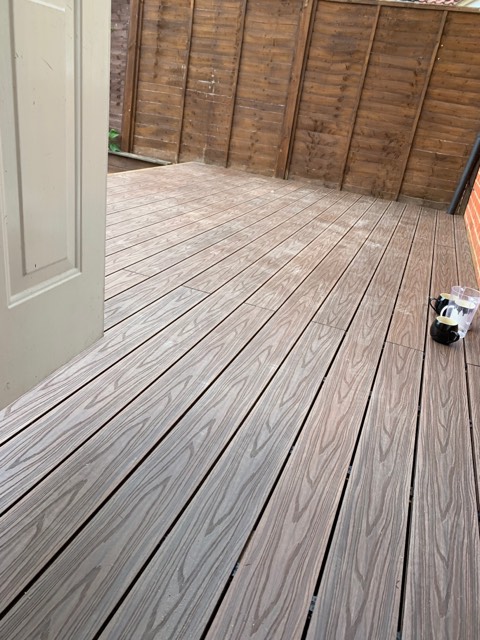We now supply and erect Composit decking.
History
Until the 1990s, wood was the material of choice for deck construction. However, new products, composites, began to emerge at this time. These new products offered the look and workability of wood, but they were more water resistant and required less maintenance. Over time, these lower maintenance decking options increased in popularity. Although the majority of decks are still built of pressure treated pine, redwood, cedar or mahogany, use of composite woods has increased as outdoor decks and living areas have become popular as home features.
Features
Working with composite lumber is similar to working with wood. However, composite lumber has the added benefit of being less likely to split or delaminate. Some composite lumber is also engineered to be lighter weight for easier handling. Composite lumber is also more stain, scratch, and mold resistant, and is therefore supposed to have a longer life than wood lumber.
Advantages
Composite lumber comes from the manufacturer as a finished product. There is no need to stain, sand, or paint the material. Composite materials usually cost more than lumber, but their long life and low-maintenance requirements could make them more economical in the long run. Many composites are often made partially out of recycled plastics and waste wood, which makes them an environmentally friendly, efficient use of resources.
Environmental Impact
The growth of wood-alternative products continues to fuel a debate about their environmental value when compared to wood, treated wood, metal and other alternatives. Many suggest that wood decking is made from a more sustainable ingredient and that it carries a smaller manufacturing carbon footprint. Others have claimed that the sawing of wood-alternative products during construction creates dust that will not biodegrade and that the wood-alternative deck boards, when they have outlived their useful lives, will not biodegrade in landfills.
Capped composite decking
Capped composite decking is composite decking, with a thin, approximately 1/16th inch, PVC-like veneer, or cap. This cap provides protection for the composite underneath. The cap is also formulated differently, in order to provide increased fade, stain, and scratch resistance. Capped composite decking is more expensive than both normal composite decking and wood decking because of the more involved manufacturing process in adding the second, co extruded layer to the board. Capped composites also lack the feel of real wood. Although manufacturers form the product with a realistic wood grain or brush stroke, some contractors and deck owners will not accept the artificial sheen. Capped composites, although formulated to resist fading, stains, and scratches, will show some wear over time, even if it is less than a normal composite or real wood product.
Composite Deck Boards are sold in either grooved or solid sided versions. The grooved composite board is fastened with hidden deck fasteners or clips, while the solid board is typically face-screwed. Most Composite Deck Board manufacturers produce 12′, 16′, or 20′ deck boards, 5-1/2″ wide, x 3/4″ high.
Manufacturers of capped composite boards will often leave one side uncapped to prevent the material from expanding and mushrooming out of the corners of the boards. This is usually the bottom side and allows the material within to expand and contract naturally during varying weather conditions, without causing lasting damage.
For more details or a quote please contact us today!




